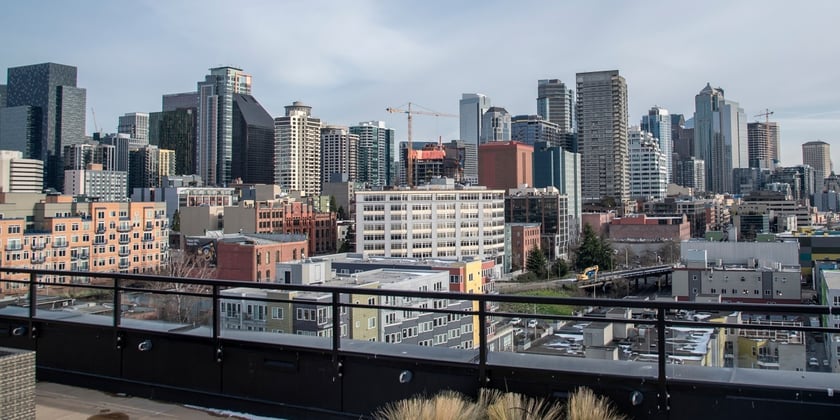https://seattletimes.com/html/businesstechnology/2025341798_rentsq4xml.html
By Sanjay Bhatt
Seattle Times business reporter
The region’s runaway rent growth could ease somewhat in 2015, as developers open thousands of new apartments, according to a new report.
The average rent for new leases in apartments in King and Snohomish counties during the fourth quarter was $1,313, an annual jump of 8 percent, according to Apartment Insights Washington, a Seattle market-research firm that tracks asking rents at properties with at least 50 units.
That increase, about four times the rate of inflation, was steeper than the 6.5 percent rise in 2013 — an acceleration that’s giving ammunition to activists who want Seattle to pursue some form of rent control. Overall, the two-county region’s vacancy rate was 4.5 percent, barely down from a year ago.
But in 2015, the firm expects the market to soften as developers open an estimated 12,273 apartment units in the two-county region, breaking the record set in 1989. Most of the new apartments are going up in Seattle — neighborhoods near downtown, plus Ballard and West Seattle and in Bellevue.
“All things being equal, if there are more units, there’s going to be more competition to rent these,” said Tom Cain, the Seattle firm’s principal.
He expects the boom in supply will slow the growth of rents, lead to more vacancies and spur more properties to offer more move-in incentives.
But greater supply doesn’t necessarily support affordable rents for the working class, said Jonathan Grant, executive director of the Tenants Union of Washington State.
Given high construction costs, the new apartments charge higher rents than existing buildings.
Even more damaging, Grant said, is speculation by developers who buy older affordable properties, like the Panorama House on First Hill, make improvements and hike the rents. And that has a ripple effect on properties nearby, Grant said.
“Until there’s some sort of rent-stabilization ordinance like they have in Los Angeles or San Francisco, we will continue to lose and hemorrhage these (affordable) units at an accelerated rate,” he said.
Ballard, a popular Seattle neighborhood that has seen the city’s biggest growth in new apartments, may offer a glimpse of the broader market’s future direction — higher vacancies.
In the fourth quarter, Ballard had the city’s highest vacancy rate, at 10.5 percent, compared to 4.2 percent a year ago.
A market-vacancy rate above 5 percent generally favors renters, as landlords offer free rent and other incentives to fill up their buildings.
Vacancy rates may actually be even higher because market researchers don’t count the inventory of new apartments leasing to their first tenants.
For example, in Ballard, Apartment Insights says there are nearly 600 new units in the process of being leased. If these units were included in the market, the vacancy rate would be 21 percent.
With the boom in new apartments, even with higher vacancy rates, Ballard’s average rent has gone up: It was $1,603 in the fourth quarter, up almost 14 percent over the year, according to Apartment Insights.
The newer apartments push the market’s average rent higher: Monthly rents at properties built since 2010 in Ballard average $1,731, whereas those built in the 1950s charge an average $1,110.
As long as the local economy keeps adding new jobs, that can push rents higher in popular neighborhoods, despite a boom in the apartment supply, Cain said.
King and Snohomish counties gained more than 45,000 jobs over the past 12 months, according to the latest available state statistics.
Downtown Seattle’s apartments were the region’s most expensive, with monthly rent for a one-bedroom at $1,785, according to Apartment Insights. Seattle’s Belltown neighborhood was in second, at $1,627, followed by West Bellevue at $1,627.
The most affordable rents for a one-bedroom apartment were in Burien and SeaTac, both at $832 a month. Not surprisingly, Burien had the region’s lowest vacancy rate, at 2.7 percent.
Across the region, one out of four properties surveyed offered move-in incentives in the fourth quarter, 70 percent more than the previous quarter. The average incentive of a $17 discount a month was double the amount in the third quarter, Cain said.
Some properties are simply lowering their asking rents. Properties in downtown Seattle, the region’s most pricey submarket, reduced their rent by an average 8 percent over the quarter. The biggest jump in rent over the quarter was in West Seattle, where rents climbed almost 6 percent to $1,236.
Renters shouldn’t expect their rents to go down next year, however, given pressure from population growth.
Since 2012, King and Snohomish counties have gained more than 78,000 people, according to the state’s estimates. Housing hasn’t kept up: The housing inventory added 24,845 units over the same period.
Even during recessions, rents have fallen only slightly, according to an analysis by Seattle-based Dupre+Scott Apartment Advisors, which surveys actual rents paid in apartments with 20 or more units.
When vacancy rates in the Puget Sound region last peaked at 7.2 percent in September 2009, average rents fell 3.7 percent over the year, Dupre+Scott reports. About 60 percent of properties offered move-in incentives.
The following March, average rents at properties surveyed by Dupre+Scott had fallen 4.4 percent, the biggest annual drop in more than a decade. The month before, the unemployment rate in King and Snohomish counties reached a record 10.1 percent.
Dupre+Scott says its annual surveys show that landlords in King County aren’t reaping a windfall: From 2000 to 2013 collected revenue rose 3.7 percent annually, while operating expenses — driven by tax and utility-rate increases — climbed more than 4 percent.




.jpg)




